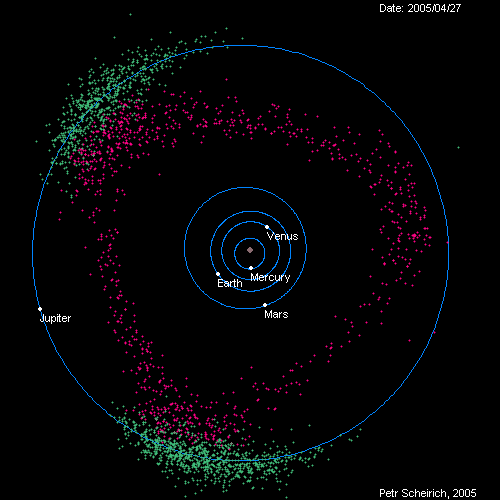The Last Episode I Posted Went Up On A Very Special Birthday That I Failed To Acknowledge Or, Well, Realize

The last episode I posted went up on a very special birthday that I failed to acknowledge or, well, realize was even happening until I saw it on the Google homepage. So, to rectify this oversight, I’m talking about the history of cosmological photography and how we reached the high point of the Hubble Space Telescope, which turned 27 this past April 24th!
Below the cut is some elaboration on the episode itself, including my sources, music credits, a glossary, and a transcript (not an exact record of this episode, but it’s the loose, fairly conversational script I was working with). I mention a couple of books and authors in this episode so if you want to see that written down, those are there too (one of the authors is Chinese and listen, Chinese is at least as hard for me to pronounce as French. I did try though). I’m also on Twitter at @HDandtheVoid, though I keep forgetting I have it. Talk to me on there and maybe I won’t forget!
Let me know what you think of this episode, let me know what you think I should research next*, tell me a fun space fact… anything’s helpful at this point!
*(Move fast if you feel strongly about what I research next, though, cuz I have to get it done by May 22nd! My thoughts were henges because I didn’t get to them this week, probes and satellites, the planets, spectroscopy, or maybe black holes? Please hit me up by May 11th so I can start working on it!)
Glossary:
catadioptric/Cassegrain telescope - use lenses and mirrors in combination.
focal length - the distance between the lens and the image sensor of a camera when the subject of the photo is in focus. According to the Nikon website this is usually measured in millimeters, but I’ll take a wild guess and say it’s probably easier to measure it in feet on the Hubble Telescope because that thing is school bus-sized.
Lagrange points - five points where three bodies can orbit each other, yet stay in the same position relative to each other in a stable configuration. L1-L3 are in line with each other, while L4 and L5 are at the points of equilateral triangles in the configuration. See an example specific to the James Webb Telescope in the link.
objective lens - the optical element that gathers light from the object being observed and focuses the light rays to produce an image at the focal point.
reflection telescope - reflects light rays off the concave surface of a parabolic mirror to get an image of a distant object. Higher contrast image, worse color quality.
refraction telescope - uses convex lenses to focus a far-off, dim image. Good color quality, poor contrast.
satellites - objects that move around a larger object. Can be man-made or natural. Geostationary satellites orbit west to east over the equator, moving in the same direction and at the same rate as Earth. Polar-orbiting satellites orbit north to south, which allows them to scan the Earth along longitude lines.
Wilkinson Microwave Anisotropy Probe—a spacecraft operating from 2001 to 2010 which measured temperature differences in the cosmic microwave background radiation leftover from the Big Bang. It orbited at L2, just like the James Webb Telescope will!
Script/Transcript (I do tend to embellish in the moment of recording so it’s not exact, but all the facts are there and I can’t know a fact and not talk about it so trust me, all you’re missing is probably another swear word or two)
Sources:
Facts about telescopes via the Naperville Astronomical Association
More facts about telescopes via Western Washington University
Earth’s atmosphere definition via the Encyclopedia Britannica Online
Correcting for atmospheric interference in astronomical imaging
Info on satellites for K-4th grade via NASA
Info on satellites for 5th-8th grade via NASA
What focal length means in photography via Nikon (the camera brand)
Hermann Oberth’s museum website
The history of NASA’s Orbiting Astronomical Observatories, which an older British gentleman seems to like enough to run a website about it
The history of OAO-3 aka Copernicus via NASA
Info on the Hubble Space Telescope for K-4th grade via NASA
Hubble-T’s 25th anniversary website, which I highly recommend. The timeline is a dream come true in terms of organization and brevity. It was last updated in December 2014, though, since that was when the Hubble was 25, so not a lot of new info there.
What the Hubble Space Telescope looks like, all its parts, and some of its history
What Hubble-T is looking at right now and why
The history of maintenance missions to the Hubble-T
Hubble: The Beginning, a 4-minute documentary video with a couple interviews, including Nancy Roman!
Hubble’s YouTube channel!!!!!!!!
Spitzer Space Telescope website
James Webb Space Telescope website
Hirshfeld, Alan. Starlight Detectives. Bellevue Library Press: NY, 2014.
Liu, Cixin. The Three-Body Problem. Trans. Ken Liu. Tor Books: NY, 2016.
Intro Music: ‘Better Times Will Come’ by No Luck Club off their album Prosperity
Filler Music: ‘Supermassive Black Hole’ by Muse off their album Black Holes and Revelations
Outro Music: ‘Fields of Russia’ by Mutefish off their album On Draught
More Posts from Fillthevoid-with-space and Others
Celebrating 17 Years of NASA’s ‘Little Earth Satellite That Could’
The satellite was little— the size of a small refrigerator; it was only supposed to last one year and constructed and operated on a shoestring budget — yet it persisted.
After 17 years of operation, more than 1,500 research papers generated and 180,000 images captured, one of NASA’s pathfinder Earth satellites for testing new satellite technologies and concepts comes to an end on March 30, 2017. The Earth Observing-1 (EO-1) satellite will be powered off on that date but will not enter Earth’s atmosphere until 2056.
“The Earth Observing-1 satellite is like The Little Engine That Could,” said Betsy Middleton, project scientist for the satellite at NASA’s Goddard Space Flight Center in Greenbelt, Maryland.
To celebrate the mission, we’re highlighting some of EO-1’s notable contributions to scientific research, spaceflight advancements and society.
Scientists Learn More About Earth in Fine Detail

This animation shifts between an image showing flooding that occurred at the Arkansas and Mississippi rivers on January 12, 2016, captured by ALI and the rivers at normal levels on February 14, 2015 taken by the Operational Land Imager on Landsat 8. Credit: NASA’s Earth Observatory
EO-1 carried the Advanced Land Imager that improved observations of forest cover, crops, coastal waters and small particles in the air known as aerosols. These improvements allowed researchers to identify smaller features on a local scale such as floods and landslides, which were especially useful for disaster support.

On the night of Sept. 6, 2014, EO-1’s Hyperion observed the ongoing eruption at Holuhraun, Iceland as shown in the above image. Partially covered by clouds, this scene shows the extent of the lava flows that had been erupting.
EO-1’s other key instrument Hyperion provided an even greater level of detail in measuring the chemical constituents of Earth’s surface— akin to going from a black and white television of the 1940s to the high-definition color televisions of today. Hyperion’s level of sophistication doesn’t just show that plants are present, but can actually differentiate between corn, sorghum and many other species and ecosystems. Scientists and forest managers used these data, for instance, to explore remote terrain or to take stock of smoke and other chemical constituents during volcanic eruptions, and how they change through time.
Crowdsourced Satellite Images of Disasters

EO-1 was one of the first satellites to capture the scene after the World Trade Center attacks (pictured above) and the flooding in New Orleans after Hurricane Katrina. EO-1 also observed the toxic sludge in western Hungary in October 2010 and a large methane leak in southern California in October 2015. All of these scenes, which EO-1 provided quick, high-quality satellite imagery of the event, were covered in major news outlets. All of these scenes were also captured because of user requests. EO-1 had the capability of being user-driven, meaning the public could submit a request to the team for where they wanted the satellite to gather data along its fixed orbits.

This image shows toxic sludge (red-orange streak) running west from an aluminum oxide plant in western Hungary after a wall broke allowing the sludge to spill from the factory on October 4, 2010. This image was taken by EO-1’s Advanced Land Imager on October 9, 2010. Credit: NASA’s Earth Observatory
Artificial Intelligence Enables More Efficient Satellite Collaboration

This image of volcanic activity on Antarctica’s Mount Erebus on May 7, 2004 was taken by EO-1’s Advanced Land Imager after sensing thermal emissions from the volcano. The satellite gave itself new orders to take another image several hours later. Credit: Earth Observatory
EO-1 was among the first satellites to be programmed with a form of artificial intelligence software, allowing the satellite to make decisions based on the data it collects. For instance, if a scientist commanded EO-1 to take a picture of an erupting volcano, the software could decide to automatically take a follow-up image the next time it passed overhead. The Autonomous Sciencecraft Experiment software was developed by NASA’s Jet Propulsion Laboratory in Pasadena, California, and was uploaded to EO-1 three years after it launched.

This image of Nassau Bahamas was taken by EO-1’s Advanced Land Imager on Oct 8, 2016, shortly after Hurricane Matthew hit. European, Japanese, Canadian, and Italian Space Agency members of the international coalition Committee on Earth Observation Satellites used their respective satellites to take images over the Caribbean islands and the U.S. Southeast coastline during Hurricane Matthew. Images were used to make flood maps in response to requests from disaster management agencies in Haiti, Dominican Republic, St. Martin, Bahamas, and the U.S. Federal Emergency Management Agency.
The artificial intelligence software also allows a group of satellites and ground sensors to communicate and coordinate with one another with no manual prompting. Called a “sensor web”, if a satellite viewed an interesting scene, it could alert other satellites on the network to collect data during their passes over the same area. Together, they more quickly observe and downlink data from the scene than waiting for human orders. NASA’s SensorWeb software reduces the wait time for data from weeks to days or hours, which is especially helpful for emergency responders.
Laying the Foundation for ‘Formation Flying’

This animation shows the Rodeo-Chediski fire on July 7, 2002, that were taken one minute apart by Landsat 7 (burned areas in red) and EO-1 (burned areas in purple). This precision formation flying allowed EO-1 to directly compare the data and performance from its land imager and the Landsat 7 ETM+. EO-1’s most important technology goal was to test ALI for future Landsat satellites, which was accomplished on Landsat 8. Credit: NASA’s Goddard Space Flight Center
EO-1 was a pioneer in precision “formation flying” that kept it orbiting Earth exactly one minute behind the Landsat 7 satellite, already in orbit. Before EO-1, no satellite had flown that close to another satellite in the same orbit. EO-1 used formation flying to do a side-by-side comparison of its onboard ALI with Landsat 7’s operational imager to compare the products from the two imagers. Today, many satellites that measure different characteristics of Earth, including the five satellites in NASA’s A Train, are positioned within seconds to minutes of one another to make observations on the surface near-simultaneously.
For more information on EO-1’s major accomplishments, visit: https://www.nasa.gov/feature/goddard/2017/celebrating-17-years-of-nasa-s-little-earth-satellite-that-could
Make sure to follow us on Tumblr for your regular dose of space: http://nasa.tumblr.com/.

Mission Specialist Mae Jemison, the first African American woman in space, during mission STS-47 .
via reddit

Great detail of the famous crawler that transported the mighty Saturn V and all the space shuttles to the launch pads. An engineering feat in its own right.
Binary star systems have come up a lot in the past 18 podcasts, and here is a perfect example of them!




As promised, here is a comic about the brightest star in the northern Hemisphere: Sirius! Sirius B will be shown in future comics as 2018 is year of the dog and since Sirius is the dog star, it is year of the Sirius!
Enjoy!
https://www.space.com/21702-sirius-brightest-star.html

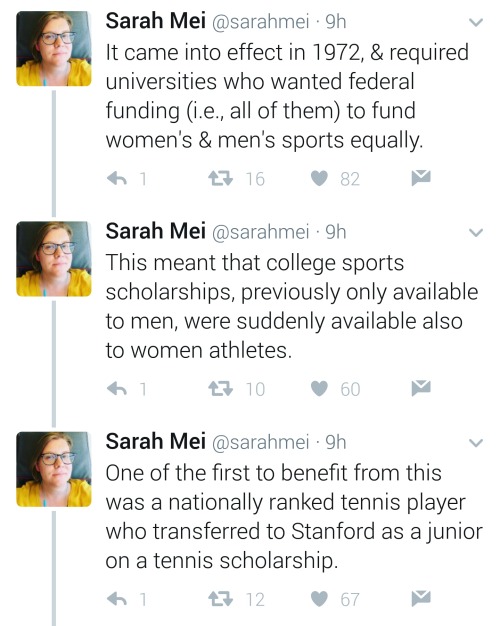
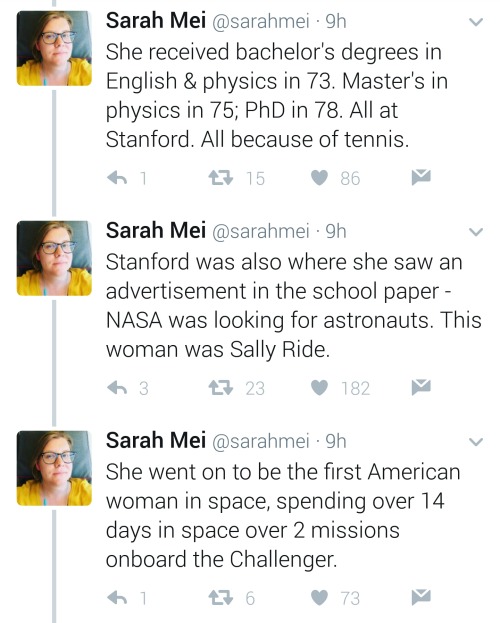
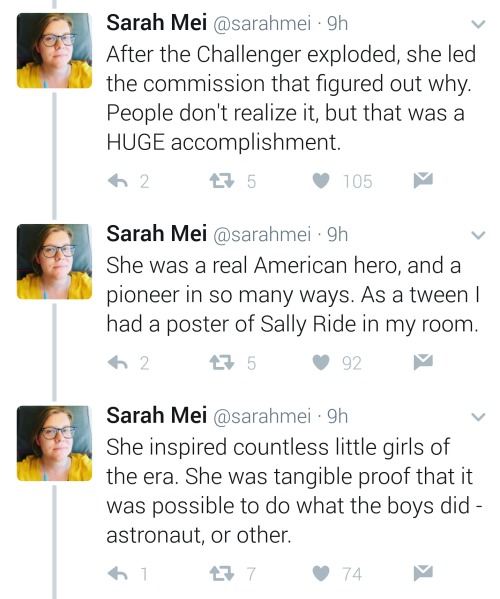
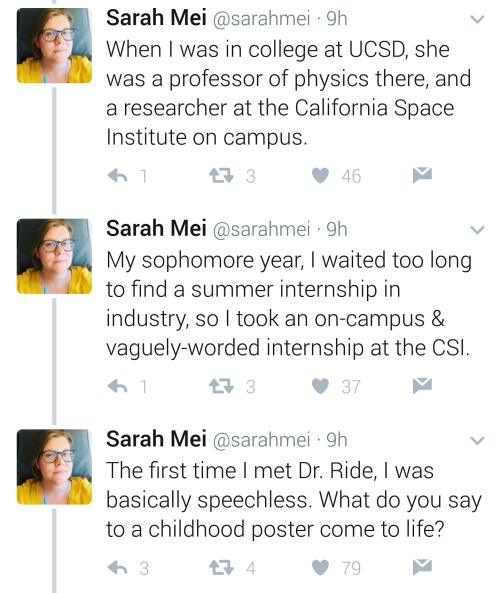
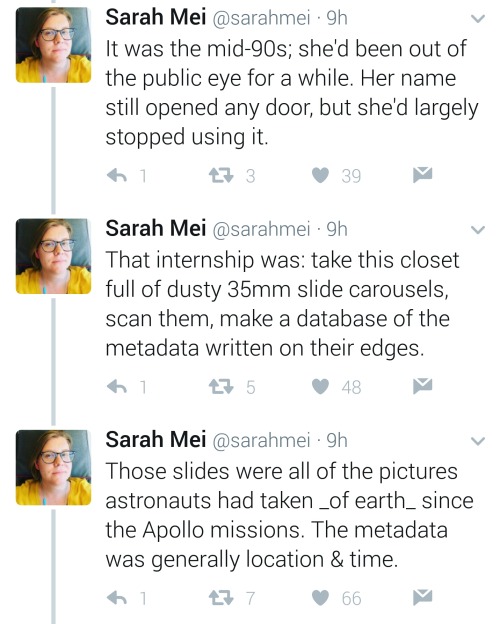
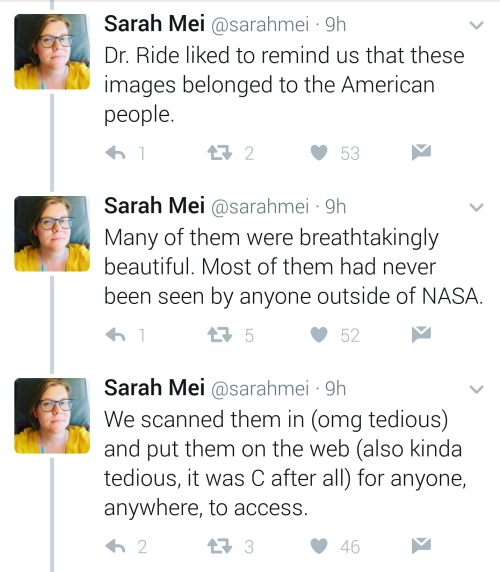
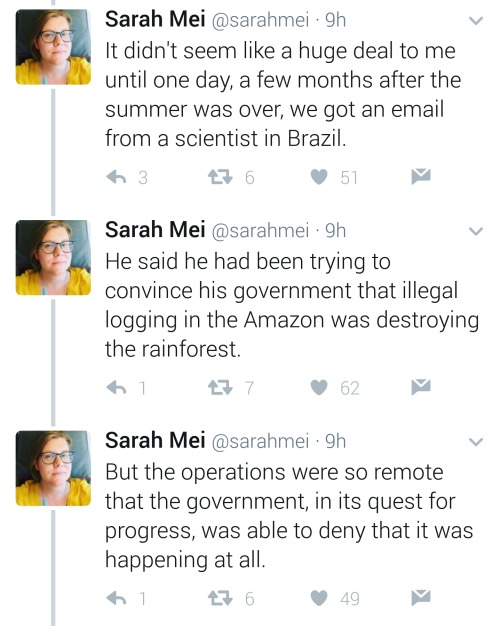
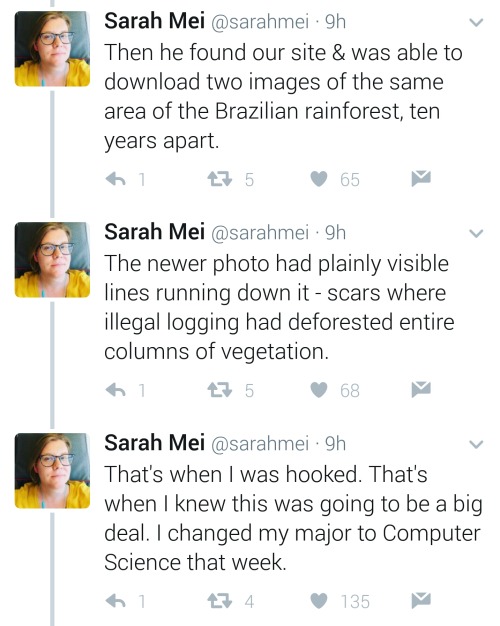
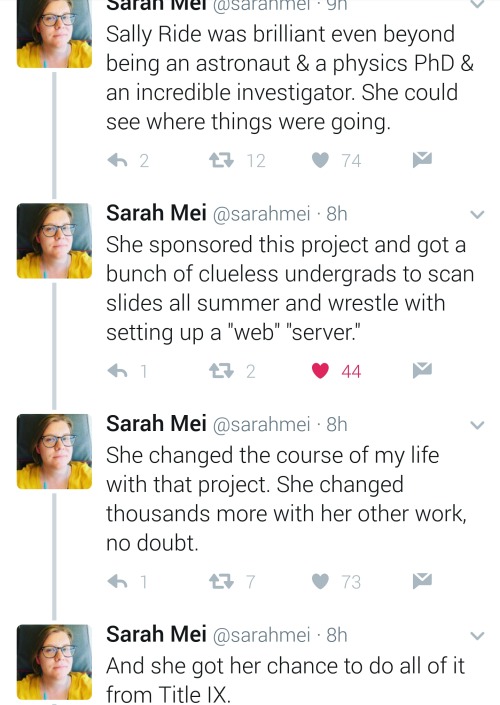
Equal opportunity benefits can be far-reaching
https://twitter.com/sarahmei/status/818682610712866817
If Earth had Saturn’s Rings
From an excellent post by Jason Davis
From Washington, D.C., the rings would only fill a portion of the sky, but appear striking nonetheless. Here, we see them at sunrise.

From Guatemala, only 14 degrees above the equator, the rings would begin to stretch across the horizon. Their reflected light would make the moon much brighter.

From Earth’s equator, Saturn’s rings would be viewed edge-on, appearing as a thin, bright line bisecting the sky.

At the March and September equinoxes, the Sun would be positioned directly over the rings, casting a dramatic shadow at the equator.

At midnight at the Tropic of Capricorn, which sits at 23 degrees south latitude, the Earth casts a shadow over the middle of the rings, while the outer portions remain lit.

via x
People can’t anticipate how much they’ll miss the natural world until they are deprived of it. I have read about submarine crewmen who haunt the sonar room, listening to whale songs and colonies of snapping shrimp. Submarine captains dispense “periscope liberty” - a chance to gaze at clouds and birds and coastlines - and remind themselves that the natural world still exists. I once met a man who told me that after landing in Christchurch, New Zealand, after a winter at the South Pole research station, he and his companions spent a couple of days just wandering around staring in awe at flowers and trees. At one point, one of them spotted a woman pushing a stroller. “A baby!” he shouted, and they all rushed across the street to see. The woman turned the stroller and ran. Nothing tops space as a barren, unnatural environment. Astronauts who had no prior interest in gardening spend hours tending experimental greenhouses. “They are our love,” said cosmonaut Vladislav Volkov of the tiny flax plants - with which they shared the confines of Salyut 1, the first Soviet space station. At least in orbit, you can look out the window and see the natural world below. On a Mars mission, once astronauts lose sight of Earth, they’ll be nothing to see outside the window. “You’ll be bathed in permanent sunlight, so you won’t eve see any stars,” astronaut Andy Thomas explained to me. “All you’ll see is black.”
Mary Roach. Packing for Mars: The Curious Science of Life in the Void (via coneyislands)
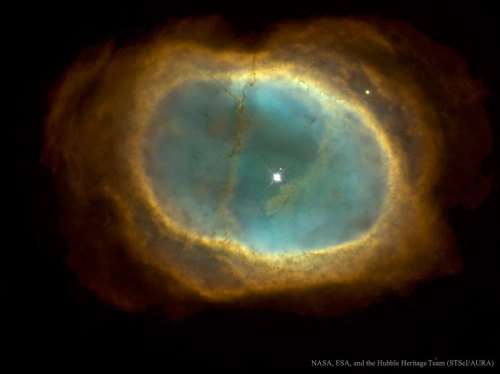
NGC 3132: The Eight Burst Nebula : Its the dim star, not the bright one, near the center of NGC 3132 that created this odd but beautiful planetary nebula. Nicknamed the Eight-Burst Nebula and the Southern Ring Nebula, the glowing gas originated in the outer layers of a star like our Sun. In this representative color picture, the hot blue pool of light seen surrounding this binary system is energized by the hot surface of the faint star. Although photographed to explore unusual symmetries, its the asymmetries that help make this planetary nebula so intriguing. Neither the unusual shape of the surrounding cooler shell nor the structure and placements of the cool filamentary dust lanes running across NGC 3132 are well understood. via NASA
js
-
 like-gossamer reblogged this · 8 years ago
like-gossamer reblogged this · 8 years ago -
 fillthevoid-with-space reblogged this · 8 years ago
fillthevoid-with-space reblogged this · 8 years ago
A podcast project to fill the space in my heart and my time that used to be filled with academic research. In 2018, that space gets filled with... MORE SPACE! Cheerfully researched, painstakingly edited, informal as hell, definitely worth everyone's time.
243 posts
